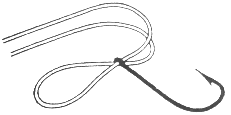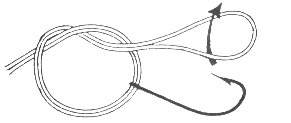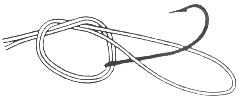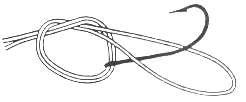COMMON KNOTS USED BY ANGLERS
When going out fishing, keep in mind the following:
When choosing a rod and reel to be used in combination, make sure that when they are secured together, they have a balanced feel in your hand. Both your rod and reel should be rated for the same line and lure weights. This assures that you can cast your lure the furthest while still having maximum sensitivity in feeling a fish bite.
When you have the proper combination of rod, reel and line, make sure the knot you use to secure your hook, swivel or lure is strong enough to withstand the shock of a fish strike.
Remember: The knot you tie is the weakest point in your line. A good knot will retain more than 90% of the strength, while an improper knot will have less than one half of the line strength.
The following are common knots used by fishermen:
Trilene Knot: A highly recommended, very strong knot

Insert tag end through eye; reinsert tag end back through eye forming a double loop. Double strands that pass through eye should not cross or overlap.

Wrap tag end around standing line; make 6 turns with light line (2–6 lb.), 5 turns with medium line (8–12 lb.), 4 turns with heavy line (14–-20 lb.).

Pass tag end through double loop at eye formed in Step 1.

Maintain tension on tag end; draw knot tight by pulling on standing line; trim tag end.
Palomar Knot: Offers maximum strength and versatility

To tie the palomar knot, bend the line back on itself to form a double strand 6 inches long.

Next, pass this double strand through the hook eye and tie a loose overhand knot, leaving a loop deep enough so the hook (or lure) can pass through it.

Pass the hook through the loop.

Then tighten the knot by pulling on the hook with one hand and the double strand of line with the other. Trim the tag end.
Improved Clinch Knot: An old standby

Insert tag end through eye leaving at least 6 inches of line to tie the knot. Wrap tag end around standing line; make 6 turns with light line (2-6 lb), 5 turns with medium line (8–12 lb.), 4 turns with heavy line (14–20 lb.).

Pass tag end through loop formed at eye.

Insert tag end back through second loop formed in Step 2.

Maintain tension on tag and draw knot tight by pulling on standing line; trim tag end.
Knotting Braided Line
See the video below from Total Fisherman for a strong knot using using braided line.



